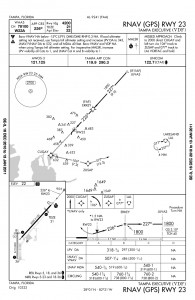
RNAV (GPS) Approach plates have four lines of approach minimums. LPV, LNAV/VNAV, LNAV, and Circling. The LPV (localizer performance with vertical guidance) minimums are for WAAS (wide area augmentation system) approaches and use electronic lateral and vertical guidance.
To fly an approach to LPV minimums a WAAS certified GPS is required to take advantage of the vertical alarm limits of between 12 and 50 meters (40 to 165 feet). To fly these approaches you must have a statement in the Aircraft Flight Manual that the installed equipment supports LPV approaches.
Many GPS and FMS (flight management system) avionics systems do not have WAAS but have advisory VNAV capability. The Baro-VNAV temperature limitation is a limitation imposed on these type of systems.
The vertical path described by VNAV systems are advisory only and are not considered primary for vertical guidance. Therefore, the pilot must comply with any published altitude including step down fix altitudes and must use the primary barometric altimeter.
For operators authorized to use Baro-VNAV avionics which provide an advisory VNAV path, a VNAV DA (decision altitude) is published. The missed approach must be executed upon reaching the published decision altitude.
Interestingly, the visibility for the VNAV decision altitude is normally greater than the visibility of the MDA because the VNAV path will bring the aircraft to a point further from the runway than if flying level at the MDA. Furthermore, the VNAV DA can not be used during extreme cold temperatures because of limitations of pressure sensing altimeters and is the reason a Baro-VNAV temperature limit is published for the LNAV/VNAV DA.
Why use LNAV DA even though the visibility is more restrictive?
First, LNAV/VNAV approaches will bring you to an altitude 100 feet below most minimum descent altitudes. In instances where the visibility is high but the ceiling is low the LNAV/VNAV DA might be your only option.
Most new avionics for both private single engine aircraft and airliners include vertical guidance. These avionics systems also provide information to the autopilot thus enabling hands off flying all the way to decision altitude or the minimum descent altitude. Therefore, we can descent using the autopilot and when we turn it off we can maintain the same pitch and power settings all the way to the transition to landing and make a more stabilized approach.
Most air carriers require some type of vertical guidance be followed during an approach even in visual conditions. Either the ILS, GPS, or a multi-sensing FMS (Flight Management System) is used to provide guidance to the runway of intended landing. Using all available navigational resources provides for a more stabilized approach, obstacle clearance, and further guarantees that we land on the runway we intend to land on.
Examples:
 So how do we determine which minimums we should use when a Baro-VNAV temperature limit is published? Let’s look at a few examples using the RNAV (GPS) to runway 23 at Tampa Executive Airport (KVDF).
So how do we determine which minimums we should use when a Baro-VNAV temperature limit is published? Let’s look at a few examples using the RNAV (GPS) to runway 23 at Tampa Executive Airport (KVDF).
For all scenarios we will assume the ILS 23 is unavailable and the winds are favoring runway 23.
Scenario 1:
The latest weather is ceiling 300 feet and 3/4 mile visibility.
Due to the 300 foot ceiling we should use the LPV minimum of 318 feet MSL and fly using our WAAS certified GPS. If you do not have WAAS the best option would be to proceed to another airport where an ILS or better weather is available.
Scenario 2:
The latest weather is 500 feet and 2 miles visibility, temperature 20 degrees Celsius, WAAS is unavailable, and we have Baro-VNAV avionics with all proper authorizations.
Due to the 500 foot ceiling we should use the LNAV/VNAV DA minimums of 507 feet and follow the VNAV advisory glide path.
Scenario 3:
The latest weather is 600 feet and 2 miles visibility, temperature - 30 degrees Celsius, WAAS is unavailable, and we have Baro-VNAV avionics and all proper authorizations.
In this case we cannot use the LNAV/VNAV DA because of the note Baro-VNAV NA below -15 C (5 F). We should use the LNAV MDA of 540 feet MSL.
Scenario 4:
The latest weather is 600 feet and 3/4 miles visibility, temperature 20 degrees Celsius, WAAS is unavailable, and we have Baro-VNAV avionics and all proper authorizations.
Due to the 3/4 mile visibility we will should use the LNAV MDA of 540 MSL.
Note:
In all the scenarios above we should use the vertical guidance provided by our avionics. Remember even though we are unable to use the VNAV or LPV minimums we should still use all vertical guidance available to us, thus providing for a more stabilized approach.
Conclusion:
Baro-VNAV temperature limits are for those using LNAV/VNAV DA minimums. If using a WAAS GPS and LPV minimums you will not need to concern yourself with the Baro-VNAV temperature limits although you should still be vigilant as to your altitude while descending in cold temperatures. Remember “hot to cold look out below”.
Recommended Reading:

Comments on this entry are closed.
Great post. However, I see the term “uncompensated Baro – VNAV” on some approach plates in the briefing section at the top. What does this mean? Example below:
“For uncompensated Baro-VNAV systems, LNAV/VNAV NA below -15°C (5°F) or above”
thank you. very good explanations. only to make itsure which temperature limits ? airport or SAT at IAF ??